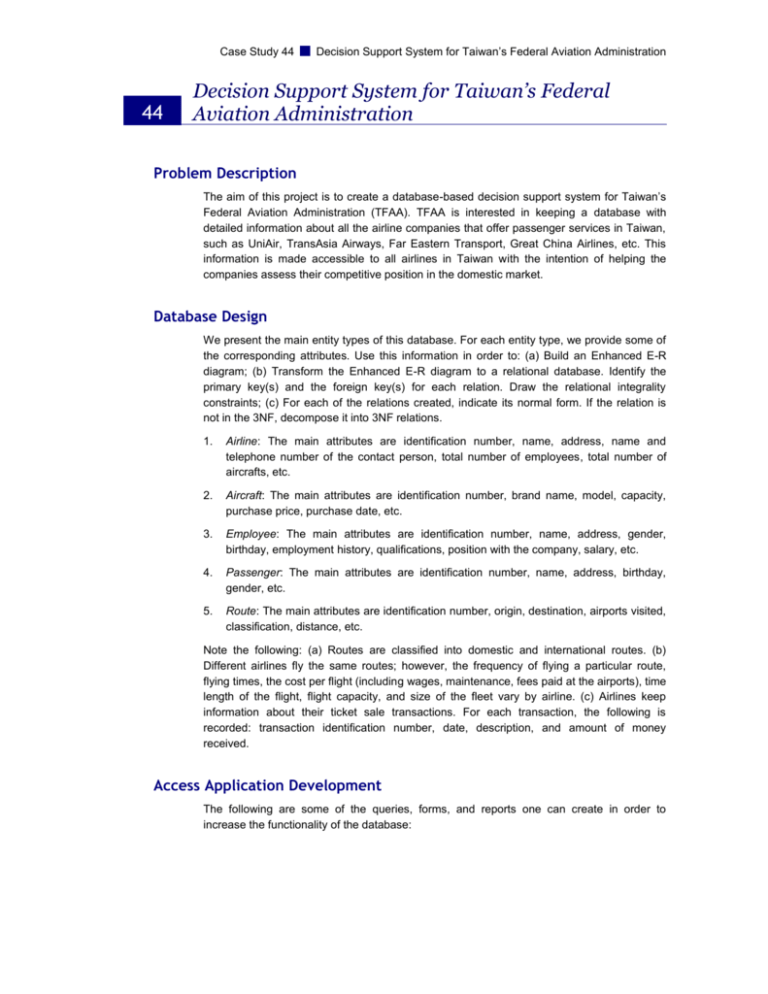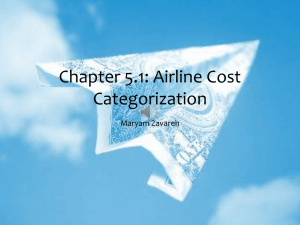Decision Support System for Taiwan's Federal Aviation
advertisement

Case Study 44
44
Decision Support System for Taiwan’s Federal Aviation Administration
Decision Support System for Taiwan’s Federal
Aviation Administration
Problem Description
The aim of this project is to create a database-based decision support system for Taiwan’s
Federal Aviation Administration (TFAA). TFAA is interested in keeping a database with
detailed information about all the airline companies that offer passenger services in Taiwan,
such as UniAir, TransAsia Airways, Far Eastern Transport, Great China Airlines, etc. This
information is made accessible to all airlines in Taiwan with the intention of helping the
companies assess their competitive position in the domestic market.
Database Design
We present the main entity types of this database. For each entity type, we provide some of
the corresponding attributes. Use this information in order to: (a) Build an Enhanced E-R
diagram; (b) Transform the Enhanced E-R diagram to a relational database. Identify the
primary key(s) and the foreign key(s) for each relation. Draw the relational integrality
constraints; (c) For each of the relations created, indicate its normal form. If the relation is
not in the 3NF, decompose it into 3NF relations.
1.
Airline: The main attributes are identification number, name, address, name and
telephone number of the contact person, total number of employees, total number of
aircrafts, etc.
2.
Aircraft: The main attributes are identification number, brand name, model, capacity,
purchase price, purchase date, etc.
3.
Employee: The main attributes are identification number, name, address, gender,
birthday, employment history, qualifications, position with the company, salary, etc.
4.
Passenger: The main attributes are identification number, name, address, birthday,
gender, etc.
5.
Route: The main attributes are identification number, origin, destination, airports visited,
classification, distance, etc.
Note the following: (a) Routes are classified into domestic and international routes. (b)
Different airlines fly the same routes; however, the frequency of flying a particular route,
flying times, the cost per flight (including wages, maintenance, fees paid at the airports), time
length of the flight, flight capacity, and size of the fleet vary by airline. (c) Airlines keep
information about their ticket sale transactions. For each transaction, the following is
recorded: transaction identification number, date, description, and amount of money
received.
Access Application Development
The following are some of the queries, forms, and reports one can create in order to
increase the functionality of the database:
Case Study 44
Decision Support System for Taiwan’s Federal Aviation Administration
Queries:
1.
2.
The following set of queries helps identify the position of each company in the market:
a.
Present the five most popular routes.
b.
Present the five least popular routes.
c.
List the flights that run on the most popular routes. For each flight, present the
following: identification number, name of the airline company, origin, destination,
start time, arrival time, duration, and price.
d.
Present for each airline the total number of flights offered and total number of
employees.
e.
Present the average number of passengers that fly per month. Group this
information by airlines.
f.
Present the average revenues generated from passenger tickets per month. Group
this information by airline.
g.
Present for each airline the total number of aircrafts owned.
The following set of queries helps with financial analysis:
a.
Create a query that presents the salary expenses per airline during the current
year.
b.
Create a query that presents the amount of money spent for buying aircrafts during
the current year. Group this information by airlines.
c.
Create a query that presents the annual revenues generated per airline during the
current year.
d.
Present the annual earnings per airline company.
3.
Create a query that prompts for an origin and a destination and returns a list of
corresponding flights. For each flight, present the following: identification number,
airline, aircraft identification number, start time, arrival time, duration, price, and number
of seats available.
4.
Create a query that prompts for the identification number of a passenger and returns
detailed information about that passenger’s reservations.
5.
Create a query that identifies the most preferred customers (passengers). Preferred
customers are the ones who have spend at least $2,000 in airline tickets during the
current year.
Forms:
1.
Create a user sign-in form together with a registration form for new users.
2.
Create the following data entry forms that are used for database administrative
functions: flights, passengers, routes, airlines, etc. These forms allow the user to add,
update, and delete information about flights, passengers, routes, airlines, etc.
3.
Create a form that allows the user to browse through the information saved in this
database about the airlines. Use textboxes to present the following for each airline:
identification number, name, address, contact information, total number of aircrafts, and
total number of employees. Insert a subform that presents detailed information about
the aircrafts owned by the selected airline. Insert another subform that presents detailed
information about the routes run by the selected airline. Insert a command button that,
Case Study 44
Decision Support System for Taiwan’s Federal Aviation Administration
when clicked-on, presents a list with detailed information about the aircrafts purchased
during the current month.
4.
Create a form that allows the user to browse through the information saved in this
database about the routes. Use textboxes to present the following information about the
selected route: identification number, origin, and destination. Insert a subform that
presents detailed information about the flights that run the selected route.
5.
Create a form that allows the users to browse through the information saved in the
database about flights. Insert a subform that presents detailed information about the
reservations made on the selected flight. Insert a textbox that presents the average
number of passengers on the selected flight. Insert a textbox that presents the average
annual earnings on the selected flight. Insert a textbox that presents the busiest time
period for the selected flight.
6.
Create a form that allows the user to browse through the information saved in the
database about the aircrafts. For each aircraft, present the following: identification
number, brand name, model, capacity, purchase price and date, and the name of the
airline that owns it. Insert a subform that presents detailed information about the flights
that use the selected aircraft. Insert a textbox that presents the average percentage
usage of the aircraft’s capacity.
Design a logo for this database. Insert this logo in the forms created above. Pick a
background color for the forms and colors for the borders of the titles. Include the following
in the forms created: record navigation command buttons, record operations command
buttons, and form operations command buttons as needed.
Reports:
1.
2.
Create the following financial summary reports:
a.
Total revenues from airplane ticket sales per airline during the current year.
b.
Total expenses from salaries and aircraft purchases per airline during the current
year.
c.
Total earnings per airline.
d.
Total revenues per route during the current year.
e.
Total revenues per aircraft during the current year.
f.
Total revenues per flight during the current year.
g.
Overall expenses, revenues, and earnings.
Use the chart wizard to plot the following:
a.
Total monthly revenues per airline during the last twelve months.
b.
Annual revenues per airline during the last five years.
c.
Total number of passengers per route per month during the last twelve months.
d.
Average percentage usage of capacity per aircraft per month during the last twelve
months.
e.
Average percentage usage of aircraft capacity per airline.
f.
Average percentage usage of aircraft capacity per route.
Case Study 44
g.
Decision Support System for Taiwan’s Federal Aviation Administration
Average percentage usage of aircraft capacity per flight.
3.
Report details about the most preferable and least preferable routes.
4.
Report details about the most preferable and least preferable flights.
5.
Report details about the most preferable and least preferable airline.
6.
Create a report that prompts for a flight identification number and presents details about
reservations made on that flight.
7.
Use the label wizard to prepare labels with the address of each airline.
8.
Report details about the aircrafts purchased during the current year.
Visual Basic.NET Application Development
This database application can be used by TFAA employees and managers, airline
employees and managers, the database administrator, etc. In the following figure we present
a tentative layout of the system.
Welcome Screen
Airlines &
Employees
Aircrafts
Flights &
Passenger
s
Statistics, Graphs
& Data Analysis
Updates
Present Results
Exit the Database
In the welcome screen, the user can choose one of the five options presented. We give
details about the forms or set of forms to be included in each option; however, you are
encouraged to add other forms you find relevant. We suggest that the queries, forms, and
reports already created in the Access Application Development section be included in here.
Airlines & Employees: Users browse this part of the database to learn about airlines and
their employees.
Aircrafts: Users browse this part of the database to learn about the specifications of the
aircrafts used by different airlines, new aircrafts purchased, aircraft capacity usage, etc.
Flights and Passengers: Users browse this part of the database to make a reservation,
compare prices and schedules, etc.
Statistics, Graphs & Data Analysis: Users browse this part of the database to identify trends
in the following: the revenues generated by airline, total number of passengers per route,
percentage usage of aircraft capacity, etc.
K T
K T
K T
min : ckt xkt hkt I kt Fkt z kt
k 1t 1
k 1t 1Case Study
k 44
1t 1 Decision Support System for Taiwan’s Federal Aviation Administration
Subject to :
K
zkt 1
Update: This form allows the user to add/delete/update the information kept in this database
about flights,for
airlines,
t 1routes,
,..., T ,aircrafts, etc.
(1)
k 1
xkt I k ,t 1 I kt Web
d kt Extension for k 1,..., K ; t 1,..., T ,
(2)
xkt Pkt z kt A user may access
for k this
1,...,
K ; t from
1,...,personal
T,
(3)
database
computers
at home or in the office. The user
xkt , I kt 0
z kt {0,1}
could be a TFAA employee, an employee or a manager of an airline, the database
for k 1,..., K ; t 1,..., T ,
(4)
administrator, etc. The user should have a login name and a password to be able to access
1,...,employees
K ; t 1,...,
T .the system
(5) to identify the following: revenues
the system. for
The kTFAA
use
generated by airline; total number of passengers by route, flight, and airline; new aircraft
purchases; aircraft average capacity usage; etc. The airline employees use the system in
order to learn about their position in the market, identify profitable routes, etc. The database
administrator can have access to the update forms. Users are allowed to update their
personal information.
Develop an ASP.NET web application that will enable the users to access the database and
perform the activities described above. Your application will have forms similar to the ones
described in the VB.NET Application section.







